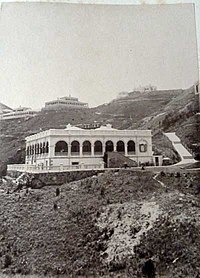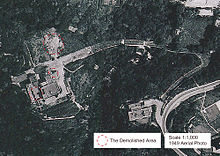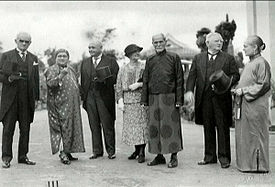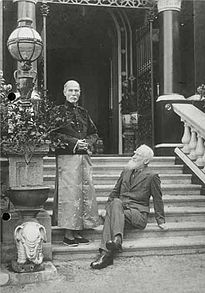
Victoria Peak is a hill on the western half of Hong Kong Island. It is also known as Mount Austin, and locally as The Peak only generally. With an elevation of 552 metres (1,811 ft), it is the tallest hill on Hong Kong Island, and the 29th tallest in the territory of Hong Kong. It is a major tourist attraction offering views of Central, Victoria Harbour, Lamma Island and the surrounding islands.
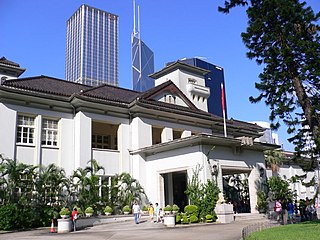
Government House, located on Government Hill in Central, Hong Kong, is the official residence of the Chief Executive of Hong Kong. It was constructed in 1855 as a Colonial Renaissance-style building, but was significantly remodelled during the Japanese occupation, resulting in the current hybrid Japanese-neoclassical form.
Declared monuments of Hong Kong are places, structures or buildings legally declared to receive the highest level of protection. In Hong Kong, declaring a monument requires consulting the Antiquities Advisory Board, the approval of the Chief Executive of Hong Kong as well as the publication of the notice on the Hong Kong Government Gazette.

The Ohel Leah Synagogue and its next-door neighbors, the Jewish Recreation Club and the Jewish Community Centre, have formed the center of Jewish social and religious life in Hong Kong for over a century. Originally the community was mostly Baghdadi and the synagogue was under the superintendence of the Haham of the Spanish and Portuguese Congregation of London: it is now fully independent and has members from across the Jewish diaspora.
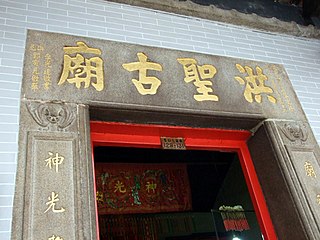
Hung Shing Temples or Tai Wong Temples are temples dedicated to Hung Shing Tai Wong. Hung Shing temples have been widely built in southern China, especially Guangdong province and in Hong Kong.

Sir Robert Ho Tung Bosman,, also known as Sir Robert Ho Tung, was a businessman and philanthropist in British Hong Kong. Known as "the grand old man of Hong Kong", he was knighted in 1915 and 1955 (KBE).

Hung Lau is a house built between 1905 and 1910 on former farmland in Pak Kok, Tuen Mun, Hong Kong. It was used by the Revive China Society (興中會) as a base for revolutionary activities against the Qing dynasty.

Fanling Lodge is an official residence of the Chief Executive of Hong Kong, which serves as a country house and occasionally hosts official functions. Built in 1934 as a summer residence for the then Governor of Hong Kong, Fanling Lodge was granted a Grade I historic building status in 2014, amid concerns about its inclusion within a new town development plan.

The Dr. Sun Yat-sen Museum is a museum in Central, Hong Kong. It is located in Kom Tong Hall, at 7 Castle Road, Central. After the preparation work undertaken by the Hong Kong Museum of History, the museum was opened on 12 December 2006, so as to commemorate the 140th birthday of the influential Chinese statesman.

The Antiquities and Monuments Ordinance, in Hong Kong Law, was enacted in 1976 to preserve the objects of historical, archaeological and palaeontological interest and for matters ancillary thereto or connected therewith. It is administered by the Antiquities Authority, with the executive support of the Antiquities and Monuments Office under the Development Bureau, since 2007.
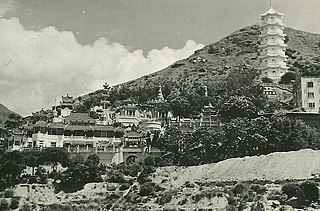
Haw Par Mansion, better known for its public gardens known as Tiger Balm Garden or Aw Boon Haw Garden, was a mansion and gardens located at 15, Tai Hang Road, Tai Hang, Wan Chai District, Hong Kong. The Tiger Balm Garden was demolished for redevelopment in 2004. The Haw Par Mansion and its private garden have been preserved.

King Yin Lei is an historic mansion in the Mid-Levels area of Hong Kong. It is within the Wan Chai District.

The Antiquities Advisory Board (AAB) is a statutory body of the Hong Kong Special Administrative Region with the responsibility of advising the Antiquities Authority on any matters relating to antiquities and monuments. The AAB was established in 1976 along with the Antiquities and Monuments Office (AMO) when the Antiquities and Monuments Ordinance (Cap. 53) was enacted, and comprises members appointed by the Chief Executive. The corresponding governmental ministry is the Development Bureau, and executive support for the AAB is provided by the AMO which is under the Development Bureau.

Tin Hau temples in Hong Kong are dedicated to Tin Hau (Mazu). Over 100 temples are dedicated to Tin Hau in Hong Kong. A list of these temples can be found below.
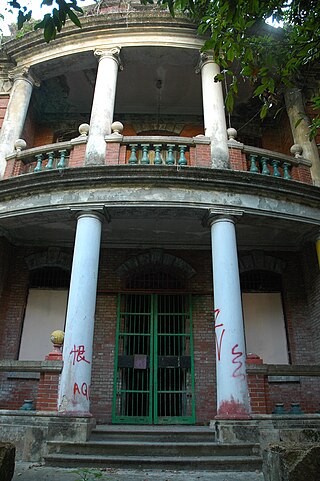
Nam Koo Terrace is a Grade I Historic Building located at No. 55 Ship Street, Wan Chai, Hong Kong, popularly known as "The Wan Chai Haunted House". The building is currently owned by Hopewell Holdings, a large property development company based in Hong Kong.

Ho Chung is a village on the Sai Kung Peninsula in Hong Kong. The Ho Chung River (蠔涌河) runs through the village.
The Hong Kong Dragon Garden is an 8 hectares private heritage garden located at No. 32-42 Castle Peak Road, Tsing Lung Tau, in the backdrop of Sham Tseng in the west of the Tsuen Wan District in the New Territories of Hong Kong, founded by Lee Iu-cheung.

Tung Lin Kok Yuen is a Buddhist nunnery and educational institution located at No.15 Shan Kwong Road in Happy Valley, Hong Kong. Founded in 1935 by Lady Clara Ho-Tung, it is home to approximately 30 nuns and 50 lay devotees.
Oi Yuen Villa is a privately owned villa located in Kwu Tung, Sheung Shui, Hong Kong. The building has been listed as a Grade I historic building since June 2017.


